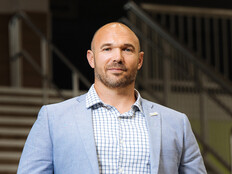Rhode Island Schools Embark on a Blended Learning Odyssey
The smallest state in the nation has undertaken the ambitious goal of becoming the first "blended learning state" in the nation.
Blended learning is an education model that integrates online instruction with the traditional classroom learning experience. Instead of all students in a classroom working from the same textbook, blended learning allows individuals to engage with material at their own pace. This approach uses a variety of resources to lead students to self-discovery and independent research.
The Rhode Island Department of Education’s transition from traditional brick-and-mortar learning to the blended method has involved a dramatic rollout of technology upgrades in the state's nearly 300 public schools, paving the way for wireless accessibility in every classroom.
Teachers Embrace Online Initiative
For its blended learning adventure, the state has partnered with The Learning Accelerator (TLA), a nonprofit that facilitates blended learning integration in school districts. The partnership comes with $100,000 and technical support from TLA, according to Education Week.
“Digital learning in all of its forms provides literally unlimited educational resources for every classroom, allows our schools to design flexible instruction schedules and enables students and teachers to work closely together at a pace that is right for each student," Deborah A. Gist, Rhode Island’s commissioner of elementary and secondary education, says in a news release.
The Hechinger Report recently spoke with Gist in August about the impact of the shift in the Ocean State's education approach. Gist said the state chose to embark on the journey organically as a result of shared enthusiasm from its teachers.
The initial round of technology funding came from the Department of Education was allocated $20 million in state funding to install wireless hardware in the state’s nearly 300 schools, an endeavor known as the state's Wireless Classroom Initiative. The technology upgrade also ensures that the state’s schools can comply with Common Core State Standards' online testing requirements.
The project is expected to be completed by the end of the 2015-2016 school year and promises to increase the percentage of wirelessly connected classrooms from 34 in 2012 to 100 in 2016.
'Technology and Curriculum Should be Joined at the Hip'
The Highlander Institute has been working behind the scenes, helping to prepare the state for its blended learning transition. Eric Butash, the institute's director of strategy and implementation, is administering the rollout of wireless technology from Cisco Systems, Aruba, HP and Aerohive.
Butash is a former district technology administrator, and he told EdTech that he's seen the technology in the education sector evolve from being "less like a division under the business department to an integral component to both curriculum and special education."
"The sooner a district realizes the importance of technology leadership and infrastructure … to the future of education, the sooner [it] can start meeting the needs of educating students in the 21st century," Butash says. "K–12 technology and curriculum departments absolutely need to be joined at the hip."
Rhode Island schools will leverage their lessons with cloud-based applications such as Google Apps for Education, Metryx and Evernote, all managed by Insightly, a communications hub. Butash calls Insightly the lynchpin of the system.
"This system not only helps us build a comprehensive profile on every district by logging all assessments, face-to-face meeting notes, emails and communications, but it also serves as our communication hub for our [Fuse RI] fellows," Butash says.
The project will also establish an open resource library system that will allow districts to share resources and work together on curriculum challenges.
“Our hope is that this system will ultimately promote collaboration and proactive district-to-district partnerships while breaking down the unnecessary silos both in-district and statewide for the advancement of teaching and learning across the state,” Butash says.
Despite the 2016 goal, Butash says many schools already have the technology they'll need to have online resources at their fingertips. The first ripples of the transformation are already being felt, including a first-grade class blogging and posting about its lessons on Instagram and an active educational community on Twitter using the hashtag #FuseRI.









